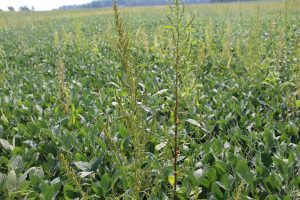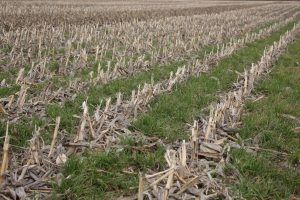Agronomy, Conservation, Homepage Slider, Water Quality
Planting Green: The Effects on Weed Control and Soybean Yield
By Dusty Sonnenberg, CCA, Ohio Field Leader: a project of the Ohio Soybean Council and soybean checkoff.
Weed control is one of the major challenges that soybean farmers face every year. Crop yields can be reduced by as much as 80% when weeds are left uncontrolled. In the Midwest, weed pressure can account for up to 39% yield loss in soybeans. On average, weed pressure impacts soybean yield more than pressure from insects, animals, and diseases combined.
Alyssa Essman is a Weed Science Research Associate at The Ohio State University, and has conducted research looking at the interaction between cover crops and weed control. She studied the impact of “planting green”, or terminating cover crops after planting soybeans, and the effect on weed control and soybean yield.

When evaluating weed control programs in Ohio, producers often think about the “Big 5” weeds that are most troublesome. Common ragweed, giant ragweed, horseweed (marestail), waterhemp, and palmer amaranth have all shown herbicide resistance and become a nuisance to farmers. “Common ragweed is more problematic in Northwest Ohio, where it has some different resistance issues than in the rest of the state. Giant ragweed has a lot of biological advantages, in terms of seed size, plant size, and especially growth rate,” said Essman. “It is very competitive and can be a real problem year after year. Horseweed (marestail) also has a number of characteristics that give it an advantage, and it can be particularly hard to deal with. It can germinate almost any time of the year, and it spreads very easily.”
There are also some “newer” weeds to Ohio that have been gaining attention. Waterhemp and Palmer amaranth are two weeds that farmers need to be able to identify and will want to keep out of their fields to prevent an outbreak from starting. These two weeds produce a large amount of seed and can infest fields in a short amount of time. “Waterhemp is starting to be an issue, especially on the west side of the state,” said Essman. “Palmer amaranth seems to be more localized where there have been introductions and so far, growers have done a good job eradicating it where it’s been found.”
In soybean production, farmers have primarily tried to use herbicide tolerant varieties of beans to control problematic weeds. “Soybeans have been one of the most rapidly adopted herbicide tolerant crops,” said Essman. “This is largely because weed control was more difficult in soybeans, and there were fewer options in soybeans for a post herbicide. These systems really simplified weed control in soybean production.”
“Herbicide resistance is a result of selection pressure, and became an issue due to the repeated use of the same herbicide sites-of-action, multiple times a year, over several years,” said Essman. “This means over time we have selected for weeds that have a higher natural tolerance to these herbicides. The small number of weeds remaining in the field each year led to populations with increased levels of tolerance. The percent of the population with higher tolerance grows over time until that herbicide is no longer effective at controlling that weed population.”
A lack of crop rotation compounds the resistance issue because it narrows the number of herbicide options available. Generally, there are a limited number of herbicide sites-of-action (SOA) available to growers.

The number of weeds developing resistance to more than one site-of-action is now a growing problem. “It is not that uncommon to find weeds with resistance to two sites-of-action” said Essman. “There has been a waterhemp population identified in Missouri that has exhibited 6-way resistance.”
The question is shifting from how farmers should deal with weeds, to how they should deal with herbicide resistance. “In the past our response has been reactive as opposed to proactive,” said Essman. “We need to consider how to combat the current situation and also find ways to slow down or prevent future instances of herbicide resistance.”
One of the best approaches to combat herbicide resistance in weeds, is to implement an integrated pest management (IPM) strategy. The concept behind IMP is to use multiple methods to attack the problem as opposed to just one single method. Biological controls, cultural controls, mechanical controls, and chemical controls all have a part in this strategy. “Research performed at universities and on farms has found that cover crops can also be one of the many control tactics needed to fight herbicide resistance issues,” said Essman.
Cover crops provide many benefits, including reducing erosion, building organic matter, decreasing nutrient loss, improving water infiltration, increasing soil biodiversity, and creating a habitat for beneficial insects and fungi. They also have been found to effectively suppress weeds.
When actively growing, cover crops compete with weeds for light, nutrients, and water. Terminated cover crop residue physically suppresses weeds by creating a barrier and blocking light from reaching the soil surface. Biomass and ground cover are the two main drivers of weed suppression by cover crops. The more biomass is produced, the more effectively it smothers weeds. High levels of ground cover also shade out or blocks the sunlight, and slows germination and growth of weeds.
In the United States, cover crop adoption has increased from 10.2 million acres in 2012 to 15.4 million acres in 2017. In Ohio, a survey was conducted form 2016-2018, and the number of acres planted with cover crops increased each year.
The objectives of the research conducted by Essman at The Ohio State University were to determine the effects of the rye seeding rate, rye termination timing, and herbicide systems on weed density in soybeans. “The hypothesis was that high seeding rates of rye combined with delayed rye termination could supplement or replace weed suppression that is typically provided by spring-applied residual pre-emergence herbicides,” said Essman.

In the two-year study, conducted from 2018-2020, three seeding rates of 0, 45, and 90 pounds of rye per acre were used. There were three termination periods which were: 7 days before planting (DBP), 7 days after planting (DAP), and 21 DAP. The spring residual component was either a control with nothing applied, or the use of Valor XLT. Each combination of factors was evaluated. The data measurements included the cover crop biomass at each termination timing, weed population density, as well as the soybean density and soybean yield.
“Results showed that rye seeding rate was one of the least important factors. The presence of rye reduced the density of giant ragweed in the trial; however, there was no difference between the 45 and 90 lb/A seeding rates on the density of giant ragweed at the time of the post-application,” said Essman. “This was consistent with other studies. Cover crop seeding rates seem to be one of the least influential factors in terms of weed suppression, especially for rye. This may be due in part to the tillering of the rye which will compensate for less biomass with increased ground cover.”
“In a visual weed pressure assessment, a 0-100% scale is often used, with 85% visual control considered acceptable,” said Essman. “In 2020, based on seeding rate, the treatments without rye did not have acceptable control, whereas the 45 and 90 pound seeding rates both had acceptable control, but were not different from each other.
“Rye terminated 21 DAP generally coincided with lowest weed density each year,” said Essman, “This was not always significantly different however from the rye terminated 7 DAP.”
“At higher weed densities we saw a greater benefit from cover crops with later termination than in lower weed densities,” said Essman. “Termination timing had the greatest effect on weed density, likely as a result of the effect on cover crop biomass.”
In the study, giant ragweed density was not affected by the pre-emerge herbicide either year. The density of giant foxtail was lower with a residual herbicide each year.
“Cereal rye used as a cover crop can reduce weed density in soybeans,” said Essman. “Making adjustments to the rye termination timing had more of an effect than adjustments to the rye seeding rate.” However, this research also found that spring-applied residual herbicides are still needed to provide adequate weed control into the growing season.
In order to evaluate whether or not the increased biomass could replace a late season herbicide application, treatments where rye was terminated 21 DAP did not receive a second post application. The first year of the study saw an increase in yields where rye was terminated 7 or 21 DAP. However, there was a slight reduction in yield where rye was terminated 21 DAP in the second year of the study, where there was giant ragweed present late season. A post application may be needed for hard to control weeds such as giant ragweed. “In this study, rye was terminated 7 days after soybean planting without reductions in the soybean yield” said Essman.
A third year of this study is being conducted. Future research will evaluate termination timing on other problem weeds, and will also evaluate the effects on weed size at the time of the post-application.